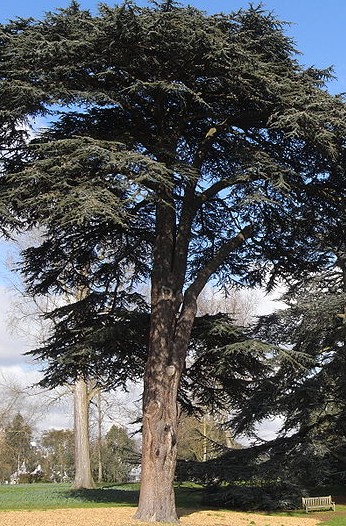 Cedar of Lebanon is an evergreen tree native to the eastern Mediterranean basin and a member of the Pine family, Pinaceae. It has a beautiful sculptural form with a thick trunk that can be over eight feet in diameter and a cone-shaped crown that broads and becomes tiered with age. The grayish-brown bark develops fissures as it matures. The horizontal branches are of two types: long ones that form the framework of the tree, and short ones that bear most of the leaves and cones. The dark green to bluish green leaves are 1.5-2.5 inches long and borne spirally on the long stems but in clusters of fifteen to forty-five on the short stems. The upright cones grow singly at the tips of the short branches with the grayish-green cylindrical male cones reaching 1.2 to 2 inches in length and the roundish female cones 2-5 inches in length. The female cones are at first green but become brown as they mature and release their winged seeds twelve months after pollination. Cedar of Lebanon do not transplant well and small ones between 18-24” tall should be selected for planting. The genus name, Cedrus, is the ancient Latin name for the genus. The specific epithet, Libani, honors Lebanon one of the native regions of the tree.
Cedar of Lebanon is an evergreen tree native to the eastern Mediterranean basin and a member of the Pine family, Pinaceae. It has a beautiful sculptural form with a thick trunk that can be over eight feet in diameter and a cone-shaped crown that broads and becomes tiered with age. The grayish-brown bark develops fissures as it matures. The horizontal branches are of two types: long ones that form the framework of the tree, and short ones that bear most of the leaves and cones. The dark green to bluish green leaves are 1.5-2.5 inches long and borne spirally on the long stems but in clusters of fifteen to forty-five on the short stems. The upright cones grow singly at the tips of the short branches with the grayish-green cylindrical male cones reaching 1.2 to 2 inches in length and the roundish female cones 2-5 inches in length. The female cones are at first green but become brown as they mature and release their winged seeds twelve months after pollination. Cedar of Lebanon do not transplant well and small ones between 18-24” tall should be selected for planting. The genus name, Cedrus, is the ancient Latin name for the genus. The specific epithet, Libani, honors Lebanon one of the native regions of the tree.
Type: Evergreen tree
Outstanding Feature: Structural form
Form: Tiered
Growth Rate: Slow to moderate
Bloom: NASize: 100’ H x 100’ W
Light: Full sun; tolerates some shade when young.
Soil: Average, medium moist, well-drained
Hardiness: Zones 7-9
Care: Low maintenance; if a double leader develops remove the weaker shoot in autumn; prune lower branches to accommodate traffic patterns if necessary.
Pests and Diseases: Aphids
Propagation: Seed, semi-hardwood cuttings
